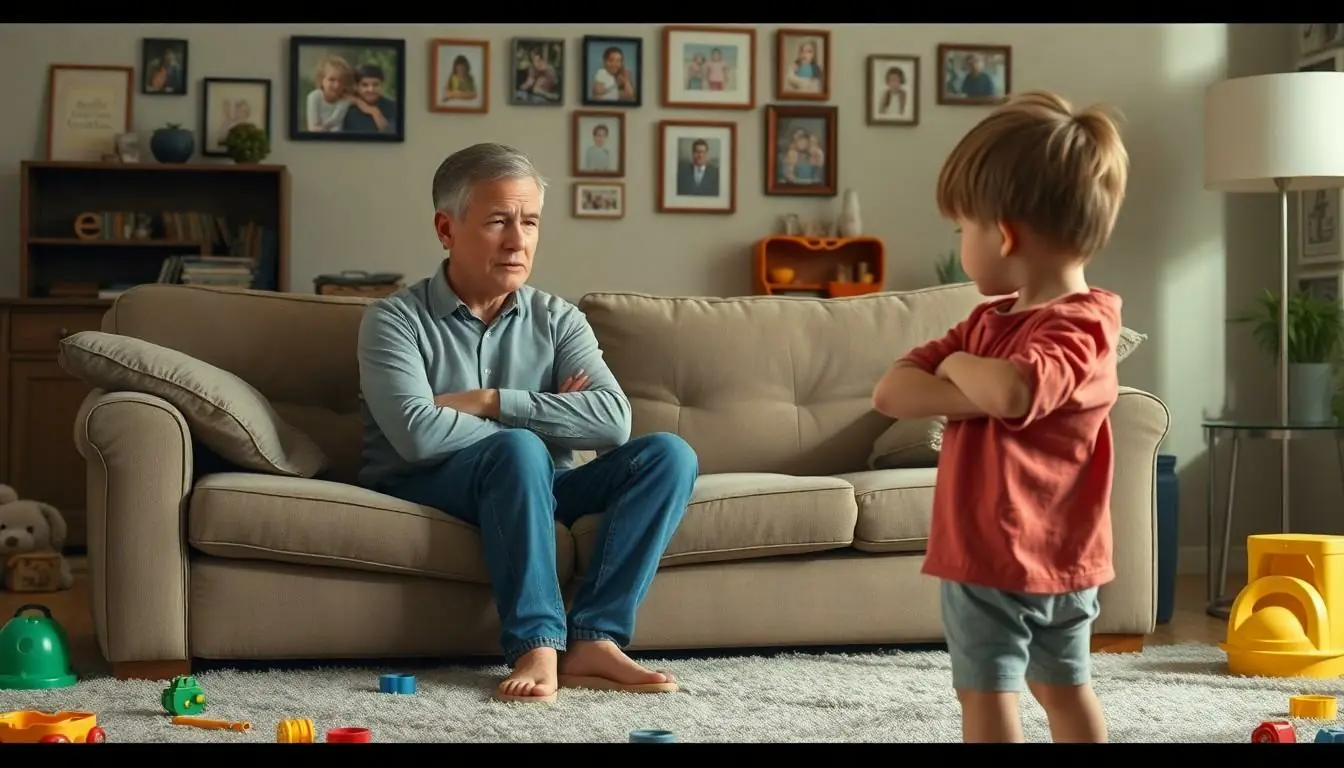Dealing with a child who shrugs off consequences like water off a duck’s back can leave even the most patient parents pulling their hair out. When time-outs become hang-out sessions and taking away privileges feels about as effective as trying to nail jello to a wall, it’s time for a different approach.
Many parents find themselves stuck in an endless cycle of implementing punishments that their children simply brush off with a casual “whatever.” This challenging behavior isn’t just frustrating – it can signal deeper issues that need addressing. The good news? There are proven strategies that can help transform a consequence-resistant child into one who understands and respects boundaries without turning every day into a battleground.
Table of Contents
ToggleUnderstanding Why Some Children Don’t Respond to Consequences
Children who appear indifferent to consequences often display specific patterns of behavior linked to deeper psychological factors. Understanding these patterns helps parents develop more effective disciplinary approaches.
Common Behavioral Patterns
Children who dismiss consequences typically exhibit defiant response patterns such as:
- Ignoring direct instructions from parents or teachers
- Continuing misbehavior immediately after receiving punishment
- Displaying a lack of emotional reaction to disciplinary measures
- Engaging in power struggles during disciplinary moments
- Testing boundaries repeatedly despite consistent enforcement
These children often demonstrate calculated responses to consequences by:
- Weighing the temporary discomfort against desired outcomes
- Trading privileges for immediate gratification
- Creating alternative scenarios to achieve their goals
- Manipulating situations to minimize impact of punishments
Underlying Emotional Issues
The root causes of consequence-resistant behavior stem from various emotional factors:
- Attachment difficulties affecting trust in authority figures
- Past trauma creating defensive behavioral mechanisms
- Anxiety manifesting as oppositional conduct
- Low self-esteem leading to attention-seeking actions
- Executive function challenges impacting impulse control
- Inconsistent parenting styles between caregivers
- Chronic stress in the home environment
- Peer influence reinforcing negative behaviors
- Academic pressures overwhelming coping abilities
- Family dynamics affecting emotional security
Evaluating Your Current Discipline Approach
Parents must examine their current disciplinary strategies to understand why consequences fail to influence their child’s behavior. This evaluation reveals patterns in both parental responses and child reactions.
Identifying Ineffective Methods
Common discipline methods often backfire with consequence-resistant children. Taking away privileges creates temporary compliance without addressing underlying behaviors. Time-outs lose effectiveness after age 7 as children learn to wait them out. Repeated groundings lead children to calculate acceptable losses against desired behaviors. Empty threats teach children to ignore warnings completely. Physical punishment damages trust while reinforcing aggressive responses. Harsh criticism focuses on the child’s character rather than specific actions, damaging self-esteem and increasing defiant behavior.
Assessing Parent-Child Communication
Communication patterns between parents and children reveal crucial insights about discipline effectiveness. Parents interrupt children 85% of the time during disciplinary conversations, limiting understanding of behavioral triggers. One-way lectures prevent children from expressing their perspectives on consequences. Hostile tone and body language create defensive responses rather than cooperation. Non-specific instructions like “be good” or “behave better” leave children unclear about expectations. Accusations trigger power struggles instead of problem-solving discussions. Clear communication focuses on specific behaviors, natural consequences and collaborative solutions.
| Communication Issue | Impact on Discipline |
|---|---|
| Parent Interruptions | 85% reduction in understanding |
| One-way Lectures | Decreased child engagement |
| Non-specific Instructions | Unclear behavioral expectations |
| Hostile Communication | Increased defiance |
Creating Meaningful and Natural Consequences
Natural consequences teach children the direct impact of their choices through real-world outcomes rather than arbitrary punishments. This approach helps children develop internal motivation and understanding of cause-and-effect relationships.
Immediate vs. Delayed Consequences
Immediate consequences create a clear connection between actions and results in a child’s mind. When a child refuses to wear a coat, feeling cold becomes an instant natural consequence. In contrast, delayed consequences require implementation within 24 hours to maintain effectiveness. Examples of effective immediate consequences include:
- Losing screen time privileges for the current day after incomplete homework
- Leaving a playdate early due to disrespectful behavior
- Missing one activity when not following safety rules
- Cleaning up spills or messes right after creating them
Connecting Actions to Outcomes
Children learn responsibility when they experience the direct results of their decisions. Parents strengthen this connection by:
- Explaining consequences beforehand: “If you don’t put away your bike, it might get damaged in the rain”
- Using cause-effect language: “You chose to skip practice, so you missed learning the new routine”
- Allowing natural results: A forgotten lunch means eating cafeteria food
- Maintaining consistency: Similar actions receive similar consequences
- Following through: Implementing stated consequences without negotiation
Each consequence links directly to the behavior, creating clear learning opportunities without punishment. This approach helps children understand their role in creating both positive and negative outcomes.
Building a Stronger Emotional Connection
Children who dismiss consequences often lack a secure emotional bond with their caregivers. Strengthening this connection creates a foundation for effective discipline through trust, understanding and mutual respect.
Quality Time and Positive Attention
Dedicated one-on-one time with children builds trust through meaningful interactions. Parents demonstrate engagement by:
- Scheduling 15-30 minutes of uninterrupted daily activities like reading stories, playing games or doing crafts
- Maintaining eye contact during conversations
- Using specific praise to reinforce positive behaviors
- Following the child’s lead during playtime
- Creating tech-free zones for focused family interaction
- Establishing consistent routines for meals, bedtime stories and morning cuddles
Regular positive attention reduces attention-seeking misbehavior and helps children feel valued, secure and understood.
Active Listening Techniques
Active listening creates emotional safety for children to express their feelings openly. Key techniques include:
- Reflecting emotions back (“You seem frustrated about…”)
- Asking open-ended questions to explore perspectives
- Pausing before responding to process the child’s words
- Maintaining an open posture with relaxed body language
- Avoiding interruptions or immediate problem-solving
- Validating feelings while setting clear boundaries
- Summarizing conversations to confirm understanding
These listening skills demonstrate empathy, reduce power struggles and encourage children to communicate their needs appropriately.
Implementing Positive Discipline Strategies
Positive discipline combines firm boundaries with emotional support to create lasting behavioral change. This approach focuses on teaching children self-regulation skills while maintaining a supportive parent-child relationship.
Setting Clear Boundaries
Clear boundaries establish predictable expectations for children’s behavior through specific rules and consistent enforcement. Parents communicate these boundaries by stating rules in positive terms, such as “Walk in the house” instead of “No running.” A family meeting creates opportunities to discuss household rules, giving children input into establishing age-appropriate limits. Environmental boundaries support behavioral expectations through organized spaces, visual schedules, designated homework areas and clear routines. Time boundaries include structured daily schedules, consistent bedtimes and defined transition periods between activities.
Using Praise and Rewards Effectively
Specific praise reinforces desired behaviors by highlighting exactly what the child did well. Comments like “You put all your toys away neatly” provide more impact than general phrases like “Good job.” A reward system uses earned privileges, such as extra playtime or special activities, to motivate positive choices. Small rewards work best when given immediately after the desired behavior occurs. Token economies allow children to earn points or stickers for following rules, which they exchange for meaningful rewards. Social rewards such as high-fives, thumbs up gestures or brief positive attention often prove more effective than material items in sustaining good behavior.
Working With Professional Support
Professional support offers specialized expertise for children who consistently resist consequences through evidence-based interventions. Mental health professionals bring objective perspectives to identify underlying causes of defiant behavior.
When to Seek Expert Help
Professional intervention becomes essential when a child exhibits persistent defiance for 6+ months despite consistent parenting efforts. Key indicators include:
- Aggressive outbursts resulting in property damage or physical harm
- Complete withdrawal from family activities or social interactions
- Declining academic performance across multiple subjects
- Sleep disruptions lasting more than 2 weeks
- Expressing thoughts of self-harm or hopelessness
- Engaging in risky behaviors like substance experimentation
- Showing signs of anxiety or depression that affect daily functioning
Types of Behavioral Therapy
- Cognitive Behavioral Therapy (CBT) teaches children to identify thought patterns leading to defiant actions
- Parent-Child Interaction Therapy (PCIT) improves communication through live-coached sessions
- Collaborative Problem Solving (CPS) develops mutual solutions between parents children
- Play Therapy helps younger children express emotions through structured activities
- Family Systems Therapy addresses dynamics affecting child behavior
| Therapy Type | Primary Focus | Typical Duration |
|---|---|---|
| CBT | Thought patterns | 12-16 weeks |
| PCIT | Parent-child bonds | 14-20 weeks |
| CPS | Problem-solving | 8-12 weeks |
| Play Therapy | Emotional expression | 16-20 weeks |
| Family Systems | Family dynamics | 12-24 weeks |
Conclusion
Disciplining a child who doesn’t care about consequences requires a comprehensive approach that goes beyond traditional punishment methods. By understanding the root causes building emotional connections and implementing positive discipline strategies parents can create lasting behavioral change.
The key lies in combining clear boundaries natural consequences and consistent follow-through while maintaining a supportive nurturing relationship. When these approaches don’t yield results seeking professional help ensures children receive the specialized support they need to develop healthy behavioral patterns.
Remember that changing a child’s response to consequences takes time patience and dedication. With the right strategies and support system parents can help their children develop the self-regulation skills needed for long-term success.




